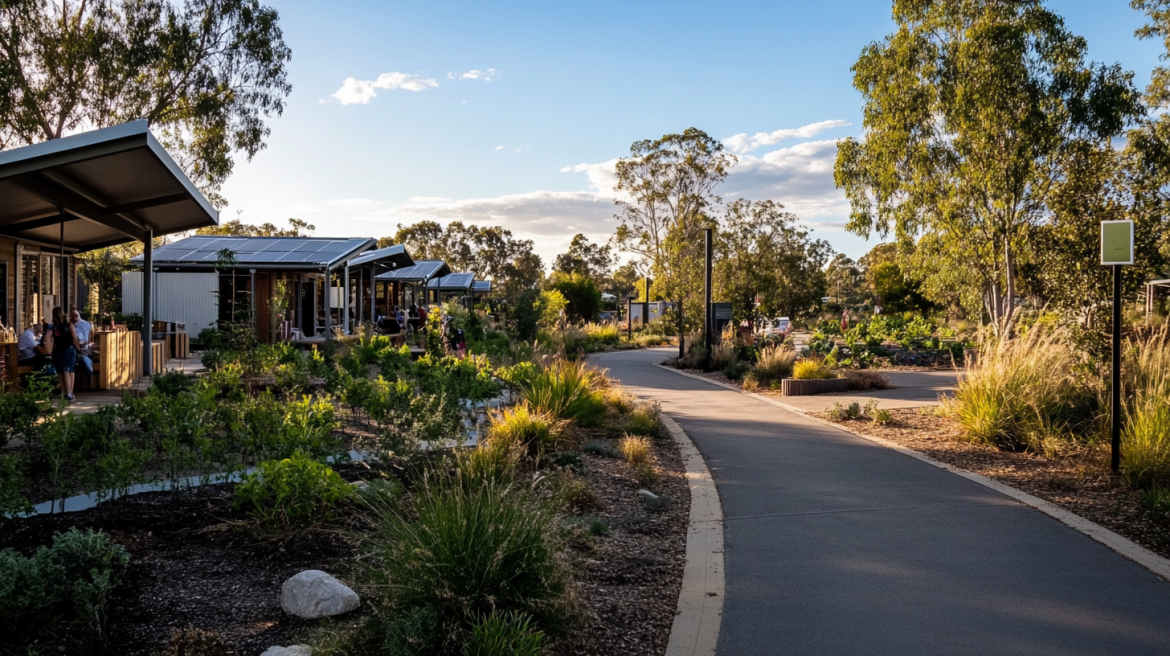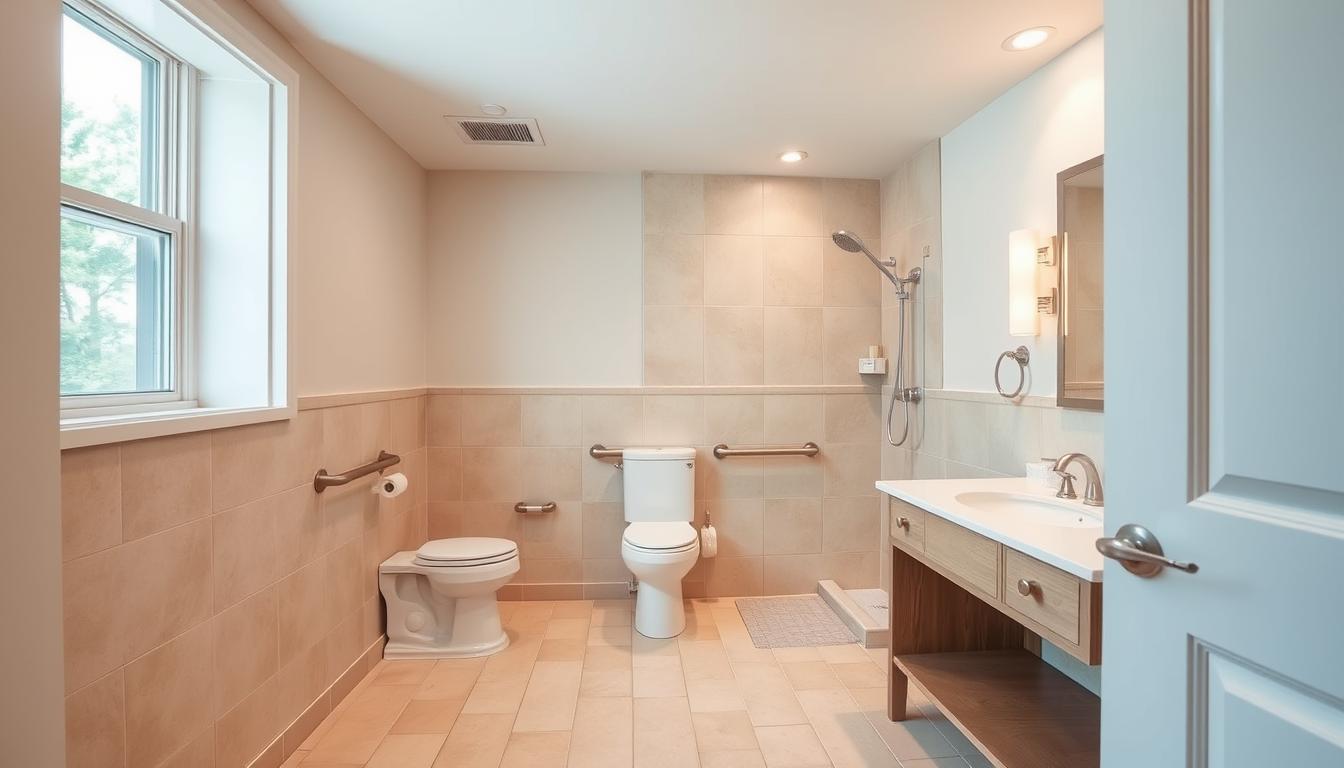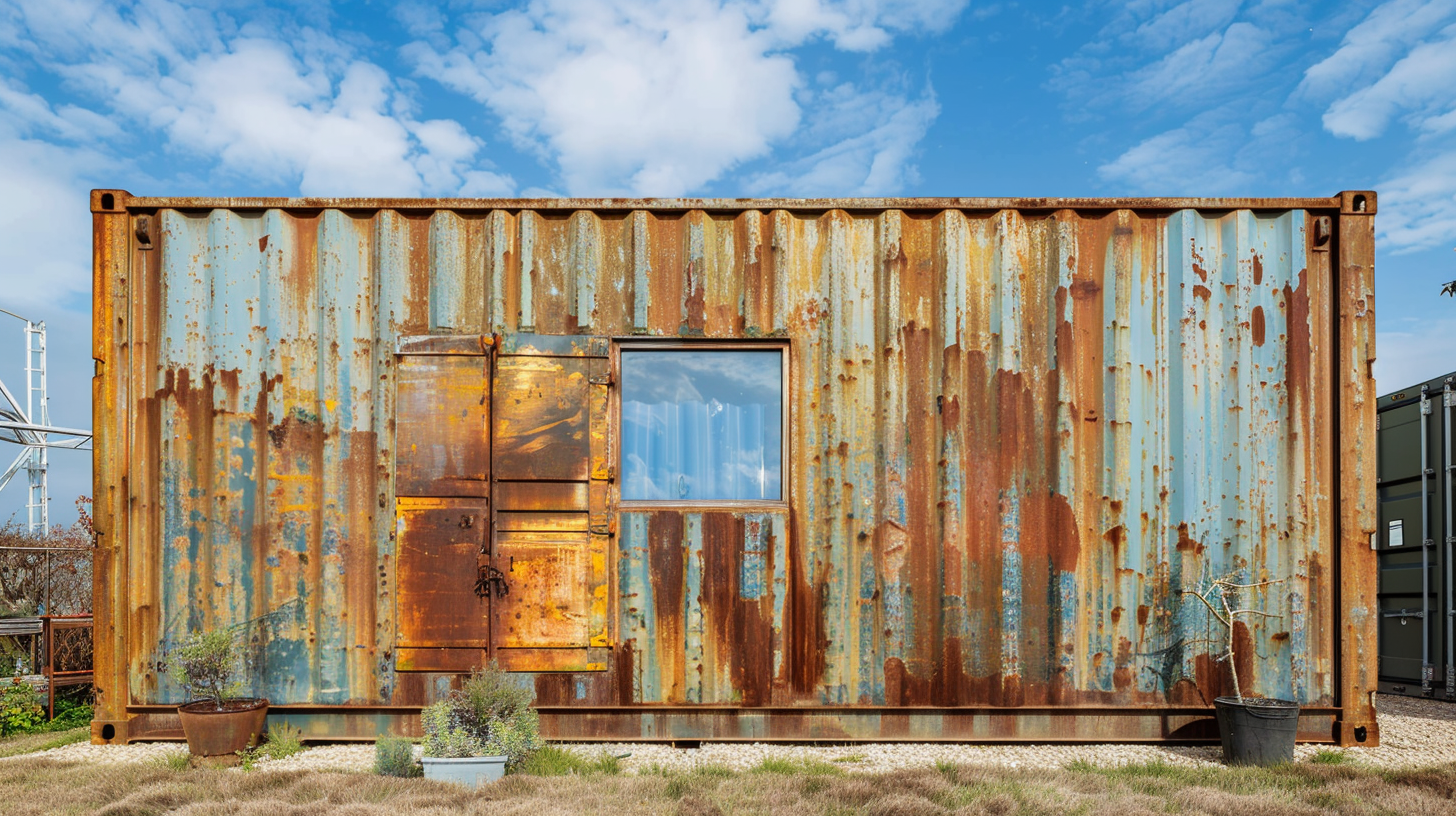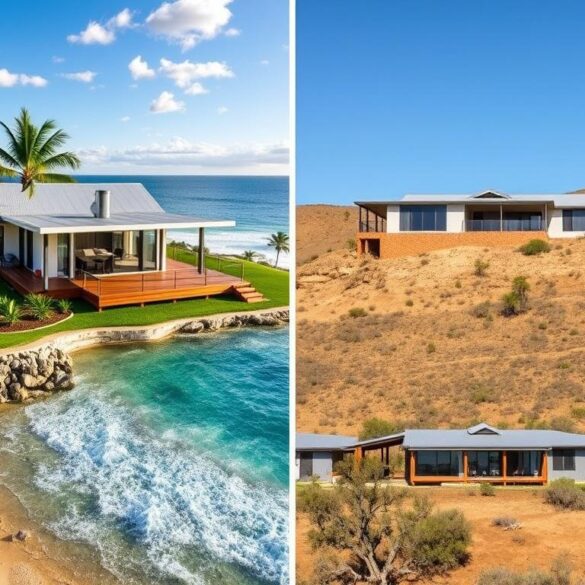Ever thought about living sustainably and being part of a tight-knit community? Co-housing Eco-villages in Australia might be what you’re searching for. These communities combine permaculture living with off-grid options, making them a hit nationwide.
Eco Villages Australia (EVA) leads this movement. They offer legal and financial help for eco-communities, usually with 5-50 members. These places aim for ecological, social, and economic success.
The idea of co-housing started in Denmark in the 1970s. Now, about 30% of Danes live in these setups. In Australia, the trend is growing, with many eco-villages popping up. These places offer both togetherness and privacy, with a central house for shared spaces like kitchens and laundry.
These eco-villages are all about being green. EVA, for example, has been carbon neutral since the start. In 2019, they bought their first site in Maleny, Queensland, showing the growth of sustainable living in Australia.
Table of Contents for Eco-villages in Australia
Key Takeaways for Eco-villages in Australia
- Co-housing eco-villages offer a sustainable living alternative in Australia
- These communities balance togetherness and privacy
- Eco-villages focus on ecological sustainability and social prosperity
- Central commonhouses provide shared facilities for residents
- The concept originated in Denmark and is gaining popularity in Australia
- Eco Villages Australia supports the development of these communities
Introduction to eco-villages In Australia
Eco-villages in Australia have become popular over the last 40 years. They offer a new way to live sustainably and together. These communities are built for people who want to live as one with nature.
Overview of co-housing eco-villages and their growing popularity in Australia
Co-housing eco-villages are popping up all over Australia. Each one has its special features. For example, Crystal Waters Ecovillage focuses on permaculture, while Narara Ecovillage has a big design.
Even city folks can find green living options. Christie Walk is a project that brings eco-friendly living to urban areas.
These communities aim to improve both people’s lives and the environment. They work on solving ecological, economic, and cultural problems. They welcome everyone, including those who are vulnerable or marginalized.
The benefits of collaborative living and sustainability
Living in an eco-village has many advantages. Homes are built to use less energy, which means lower bills. Some residents even pay just a few hundred dollars a year.
These green villages are full of sustainable features. You’ll see solar panels, rainwater systems, and community gardens. They’re also setting up solar-powered EV charging stations for the future.
These communities also promote healthy living. They have shared pools, gyms, and green spaces. This encourages people to be active and social. It also gives residents a sense of purpose and belonging.
“Eco-villages blend sustainability with community, offering a unique living experience that benefits both people and the planet.”
If you’re interested in this lifestyle, you can buy property in an eco-village. You can choose from buying a lot or moving into an existing home. Some communities even offer short-term stays for those who want to try it out.
What is Co-housing?
Co-housing is a special way to live where you have your own home and share spaces with others. It’s becoming more popular in environmental villages in Australia. Here, you get your place but also enjoy big kitchens, dining areas, and places to play together.
Eco-villages in Australia Concept
Eco-villages are a step further, focusing on being green and caring for the planet. They often have farms and use no grid. In an eco-village, you work with your neighbors to keep things sustainable.

Types of Co-housing Arrangements
There are many types of co-housing to fit different lifestyles:
- Urban and suburban models for socializing
- Rural eco-villages for organic farming
- Cooperative housing with flexible ownership
- Co-living spaces for short-term stays in cities
Co-housing communities usually have 8-50 homes. They balance community life with personal space. Whether you want a tight-knit urban spot or a rural retreat, there’s a co-housing option for you.
“Co-housing is a model that can address issues like loneliness, mental health, housing affordability, homelessness, food security, and sustainability.”
Choosing co-housing means more than just a place to live. It’s about joining a movement for sustainable living and building strong community ties.
Benefits of Eco-villages
Eco-villages combine community living, green practices, and financial perks. They are becoming popular as a way of life that focuses on green homes and working together.
Community Living
In eco-villages, you’ll find a strong community spirit. For instance, Aldinga Arts Eco Village in Australia has over 350 residents. It’s run by a community corporation with nine groups deciding on needs.
This setup creates a supportive place where you can connect with others who share your values.

Sustainability Practices
Eco-villages focus on living green. At Aldinga Arts, most homes use solar panels and have hot water systems. The community collects rainwater, making it self-sufficient in water.
This cuts down on water bills and helps the environment. The village also uses swales and ponds to manage stormwater, improving soil and water quality.
Financial Advantages
Living in an eco-village can save money. Homes at Aldinga Arts start at $250,000 for a 150 square meter lot. The community’s green living reduces utility costs.
Residents pay lower fees for common areas than council rates. Some places, like Narara Ecovillage in NSW, aim to sell energy at good prices.
“Eco-villages redefine traditional housing models, offering a path to sustainable living that’s both financially accessible and community-oriented.” – Sustainable Home Magazine
Choosing an eco-village means more than just a home. It’s about joining a community that values green living, working together, and smart finances. These are the keys to a happy and responsible life.
Community Structure and Decision-Making
Eco-villages in Australia have unique ways of making decisions. They focus on working together and listening to everyone’s ideas. This helps them live in a way that’s good for the planet.
Participatory Governance Models
Many eco-villages use Sociocracy. It’s a system that values openness and teamwork. In meetings, everyone sits in a circle and shares their thoughts equally. This makes sure decisions are made with the community’s best interests in mind.

Sociocracy helps solve problems by encouraging clear communication. It’s becoming more popular in eco-villages around the world. Co-housing communities see how well it works in creating a peaceful place to live.
Role of Collective Stewardship
Collective stewardship is key in eco-villages. People work together on gardening, upkeep, and making decisions. This way, everyone helps out and feels connected, making sustainable living easier.
| Governance Aspect | Implementation in Eco-villages |
|---|---|
| Decision-making | The balance between privacy and shared activities |
| Conflict Resolution | Promotes understanding and respectful communication |
| Organizational Structure | Interconnected circles for efficient information flow |
| Community Engagement | Balance between privacy and shared activities |
Eco-villages use these models to build strong, resilient communities. They’re ready to tackle environmental issues and foster a sense of belonging among their members.
Legal and Financial Models
Eco-villages in Australia face unique legal and financial challenges. These permaculture villages need innovative solutions to thrive. Let’s explore the key aspects of creating sustainable communities.
Understanding Community Land Trusts
Community Land Trusts (CLTs) offer a promising model for eco-friendly living. Dr. Louise Crabtree has been researching affordable housing options related to CLTs since 2010. Her team developed two main options for Australian CLTs: long-term leasehold and shared equity of the entire house and land.
CLTs in Australia focus on:
- Providing ongoing affordable housing
- Resale-restricted home ownership
- Rental housing
- Housing cooperatives
These models address sustainability concerns in housing design while promoting renewable energy sources. The UK’s fast-growing CLT sector has inspired similar developments in Australia.
Legal Challenges and Solutions
Eco-villages face several legal hurdles. Crystal Waters Eco Village, for example, was one of the first to use a body corporate structure in rural Queensland. This innovative approach helped overcome zoning issues.
- The Australian Community Land Trust Manual
- A toolkit for implementing new affordable housing models
- Case studies tracking progress in Victoria and Tasmania
These resources help eco-villages navigate complex legal and financial landscapes. They’re crucial for creating sustainable communities that balance affordability with environmental responsibility.
“The housing market may shift towards more energy-effective and better quality housing with the developments seen in the community housing sector.” – Dr. Louise Crabtree
As eco-villages grow, they’re influencing policy discussions. Recent Council of Australian Governments white papers have mentioned CLT models for Aboriginal and Torres Strait Islander communities, showing their increasing relevance in sustainable development.
Successful Eco-villages
Australia is home to many eco-villages that live sustainably. These renewable energy villages are great examples for those wanting to live green.
Examples from Australia
In Australia, eco-villages show new ways to live sustainably. They use community gardens, natural buildings, and green energy. This makes living spaces that are in tune with nature.
Crystal Waters Eco-Village Qld
Crystal Waters is in Queensland and has 200 residents. It covers 640 acres, with only 20% used for homes and businesses. The rest is kept wild. The community follows permaculture and uses green energy.
Narara Eco-Village NSW
Narara Eco-Village in New South Wales is all about living green and working together. It has gardens, natural buildings, and shared spaces. These help people connect and care for the planet.
Lessons Learned
Successful eco-villages teach us important lessons:
- Working together is crucial for eco-villages to thrive
- Green energy can power everything
- Building with nature reduces harm to the environment
- Gardens help with food and bring people together
These eco-villages show that living sustainably and in the community is not just possible. It’s also very fulfilling. They motivate others to try living in ways that care for the planet and build strong bonds.
How to Start Your Eco-village
Starting an eco-village in Australia is an exciting journey. It’s a step towards living more sustainably. This guide will help you create your permaculture-based community.
Practical Steps for Initiation
First, find suitable land. Look for properties like the one near Moe, about 90 minutes from Melbourne. It spans 20 acres. Half-wooded areas are ideal, offering a balance of buildable land and natural resources.
Next, think about your budget. A starting investment of $100,000 can kickstart your project. Plan for alternative housing like yurts, shipping container homes, or earthships. This keeps costs down and aligns with sustainability goals.
Focus on creating a small community. Emphasize radical simplicity, renewable energy, and high self-sufficiency. This showcases sustainable living practices and attracts like-minded individuals.
Resources and Support Networks
Tap into existing networks for guidance. The Maleny Eco Village model is a good example. It includes collective housing for 5-25 people. Their approach focuses on nature preservation and ecosystem regeneration.
Follow this five-step process for community success:
- Establish clear agreements
- Choose a land-ownership model
- Navigate council regulations and building codes
- Select a conflict resolution method
- Provide resources for community development
Remember, sustainable communities aim to reduce carbon emissions. The average Australian emits 15 tonnes of carbon per year. Eco-villages target a reduction of 2 tonnes per person.
| Aspect | Traditional Living | Eco-village Living |
|---|---|---|
| Carbon Emissions | 15 tonnes/person/year | 2 tonnes/person/year |
| Land Use | Majority for housing | 10% house, 90% land |
| Housing Options | Conventional homes | Yurts, container homes, earthships |
Community Living Stats
| Aspect | Data |
|---|---|
| Full-time Residents | ~45 (including children) |
| Community Title Developments in NSW | Over 700 |
| Pets Allowed | Varies (some restrict for wildlife protection) |
| Business Operations | Home-based businesses allowed (zoning dependent) |
Joining an eco-village means embracing a lifestyle that balances personal space with communal living. It’s an opportunity to live in harmony with nature while being part of a vibrant, like-minded community.
Final Thoughts
Co-housing eco-villages are changing how we live in Australia. They mix living together with caring for the planet. This makes them a great choice for those wanting a closer community.
Importance of co-housing eco-villages in promoting sustainable living
Eco-villages like Maleny and Narara are becoming more important. Maleny Eco Village started in 2019 and shows how small groups can work together. Narara Ecovillage’s Open Day in May 2019 drew many visitors, showing more people want to live eco-friendly.
Benefits of joining or starting a co-housing community
Being part of a co-housing community has many perks. The Witchcliffe Ecovillage is a top example. It’s won awards for being green and affordable, aiming to house 1,000 people in a self-sufficient way. It shows sustainable living is possible and appealing.
As more people get interested, resources like Sustainable Home Magazine (https://sustainablehomemag.com) offer helpful tips. Eco-villages are featured in places like Australian Geographic and Sanctuary. This shows communal living is not just a trend but a real way to a greener future.









1 comment
Would you please keep me on your mailing list. Are there any vacancies in NSW or do these villages have maximum capacity? Thank you